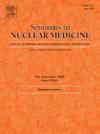成纤维细胞活化蛋白抑制剂(FAPI) PET在肉瘤中的应用:最新进展和未来展望。
IF 5.9
2区 医学
Q1 RADIOLOGY, NUCLEAR MEDICINE & MEDICAL IMAGING
引用次数: 0
摘要
近年来,核医学取得了重大进展,特别是在正电子发射断层扫描(PET)成像领域。其中一个创新是使用成纤维细胞活化蛋白抑制剂(FAPI)作为一种新的放射性示踪剂。FAPI PET成像在各种恶性肿瘤中显示出令人鼓舞的结果,包括肉瘤,这是一种起源于间充质细胞的不同类型的癌症。本综述旨在探讨FAPI PET成像在肉瘤的诊断、分期和治疗监测中的潜力。一些研究已经证明了FAPI PET在肉瘤中的潜力。此外,FAPI PET成像显示出评估治疗反应的潜力,FAPI摄取的变化与治疗结果相关。然而,也有一些挑战需要解决。肉瘤的异质性(肿瘤间和肿瘤内)可能影响成纤维细胞活化蛋白(FAP)表达的均匀性,从而影响FAPI PET成像的有效性。总之,FAPI PET成像的引入代表了核医学和肿瘤学领域的重大进步。随着我们对这种新型成像技术的理解不断加深,希望FAPI PET成像在与癌症的斗争中发挥越来越重要的作用。然而,与任何新技术一样,需要进一步的研究来充分了解FAPI PET成像在临床环境中的潜力和局限性。本文章由计算机程序翻译,如有差异,请以英文原文为准。
Fibroblast Activation Protein Inhibitor (FAPI) PET in Sarcoma: An Update and Future Perspective
Nuclear medicine has seen significant advancements in recent years, especially in the area of Positron Emission Tomography (PET) imaging. One of these innovations is the use of Fibroblast Activation Protein Inhibitors (FAPI) as a novel radiotracer. FAPI PET imaging has shown promising results in various malignancies, including sarcomas, which are a diverse group of cancers originating from mesenchymal cells. This review aims to explore the potential of FAPI PET imaging in the diagnosis, staging, and treatment monitoring of sarcomas. Several studies have demonstrated the potential of FAPI PET in sarcomas. Furthermore, FAPI PET imaging has shown potential in assessing treatment response, with changes in FAPI uptake correlating with treatment outcomes. However, there are challenges to be addressed. The heterogeneity of sarcomas, both inter- and intra-tumoral, may affect the uniformity of Fibroblast Activation Protein (FAP) expression and thus the effectiveness of FAPI PET imaging. In conclusion, the introduction of FAPI PET imaging represents a significant advancement in the field of nuclear medicine and oncology. As we continue to deepen our understanding of this novel imaging technique, it is hoped that FAPI PET imaging will play an increasingly important role in the fight against cancer. However, as with any new technology, further research is needed to fully understand the potential and limitations of FAPI PET imaging in the clinical setting.
求助全文
通过发布文献求助,成功后即可免费获取论文全文。
去求助
来源期刊

Seminars in nuclear medicine
医学-核医学
CiteScore
9.80
自引率
6.10%
发文量
86
审稿时长
14 days
期刊介绍:
Seminars in Nuclear Medicine is the leading review journal in nuclear medicine. Each issue brings you expert reviews and commentary on a single topic as selected by the Editors. The journal contains extensive coverage of the field of nuclear medicine, including PET, SPECT, and other molecular imaging studies, and related imaging studies. Full-color illustrations are used throughout to highlight important findings. Seminars is included in PubMed/Medline, Thomson/ISI, and other major scientific indexes.
 求助内容:
求助内容: 应助结果提醒方式:
应助结果提醒方式:


